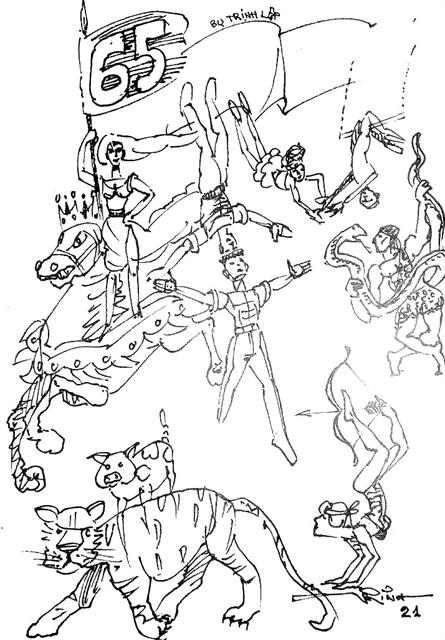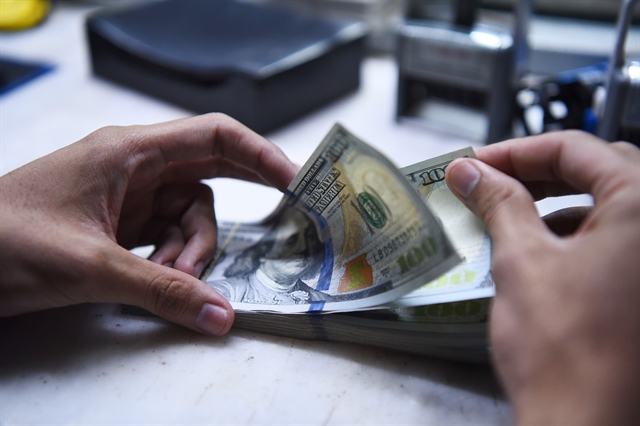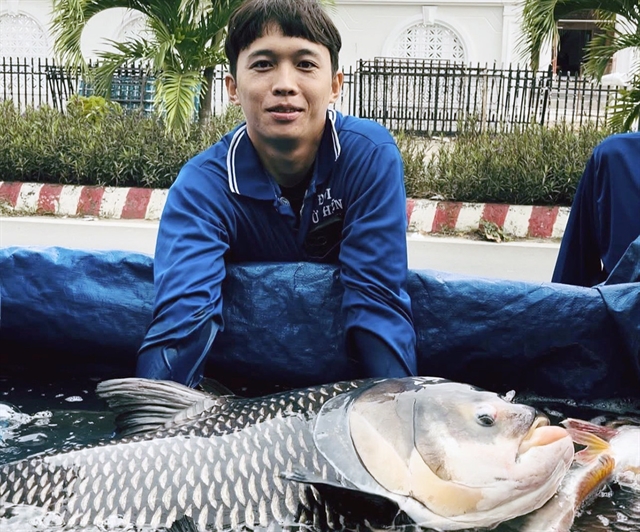 Talk Around Town
Talk Around Town

The Việt Nam Circus Federation has just celebrated its 65th anniversary, which is an occasion for the sector’s workers to review its history and development.
By Trần Hoàng Nam
The Việt Nam Circus Federation has recently celebrated its 65th anniversary, presenting an occasion for those involved in the entertaining art to take a look back over its history and development.
“Documents say that in the early 20th century, modern circus troupes from China, Japan, the UK, Mexico, the Philippines and India began performing in Việt Nam,” according to historian Lê Văn Lan.
Following the widespread appearance of these Western circus troupes, a number of Vietnamese troupes were put together and began performing regularly.

|
| Illustration by Trịnh Lập |
Among the first were the Andre Thận Troupe, in Sa Đéc in 1917, the Năm Tú Circus Troupe in Mỹ Tho in 1918, the Tân Nam Việt Circus Troupe in Sài Gòn in 1922, and the Việt Nam Circus Troupe in Hà Nội in 1922, run by artist Tạ Duy Hiển.
One historical document records the first performance by Tạ Duy Hiển’s troupe in what is today Hàng Da Market in the capital’s downtown area, which pioneered performing on a circus ring and featured animals such as elephants, tigers, bears, and horses.
According to artist Vũ Ngọan Hợp, former director of the federation, after the French were ousted from Việt Nam’s north, Tạ Duy Hiển and members of his troupe gathered together in 1956 as the Central Circus Troupe, the original version of the Việt Nam Circus Federation.
After entertaining local audiences, the troupe went abroad six years later to perform in China, the Soviet Union, Mongolia, and Eastern European countries.
Hợp said the art form’s halcyon days were in the 1970s and 1980s, when many talented circus performers were trained in the Soviet Union and Eastern Europe.
The circus, back then, was a hugely popular form of entertainment.
Like other theatrical art forms, though, it fell into crisis in the early 2000s amid competition from other pursuits.
“Many people began to equate the circus with kids’ entertainment and not something for adults,” Hợp said.
He was one of hundreds of circus performers who found themselves struggling to keep their careers afloat.
“Most found other jobs,” he recalled. “Some worked as make-up artists, some as electricians, and some as builders. But a few times every week we gathered together on stage to practise for a few shows every month.”
Despite the travails, though, the federation still picked up dozens of medals at international circus festivals.
Then came the country’s integration period, when many artists recognised they needed to renew not only their basic techniques but also the way of conveying the stories in a performance.
Lại Khánh Toàn, a frequent visitor to the circus ring, said it was clear that Vietnamese circus acts had advanced.
“So many different acts have been trialled over the last few years,” he said.
The International Circus Gala 2016 in Hà Nội was the first time a circus had been held as the background of live opera and chamber music performance.
A number of circus acts were then created that retold legends of yore.
Toàn said he and his grandchildren were excited to see the latest show, Cây Gậy Thần (Magic Stick), which combines circus and cải lương (reformed opera).
The script from playwright Hoàng Luyện is based on the legend of a poor man, Chử Đồng Tử, and a princess, Tiên Dung. The cải lương opera - circus show lasts for over an hour.
More than 100 artists from the Việt Nam Cải Lương Theatre and the Việt Nam Circus Federation perform, transforming into legendary characters and showing off the magic of the circus.
According to People’s Artist Triệu Trung Kiên, acting director of the cải lương theatre, the stage used to perform the art is normally quite static but has been very much livened up by the addition of the circus.
Circus artists will not show off single circus techniques but performing their skills on the background of cải lương singing to express the characters’ feelings. The main story is performed in cải lương, while the main characters sing cải lương melodies and also perform circus techniques.
“I think it’s appealing to both adults and children,” Toàn said. “It’s quite an interesting show, in terms of both art and content.”
Seven-year-old Lại Văn Long, Toàn’s grandson, said he understood the story and enjoyed seeing animals like buffaloes, goats, dogs and horses perform on stage.
For Toàn, the whole set-up is really innovative.
“Despite how much modern entertainment has taken over, the circus remains in the hearts of so many people,” he said.
“You can see it in the faces of the kids in the audience with their parents or classmates.”
Tickets to a circus performance still count among the gifts parents may give their children on special occasions.
“Throughout the ups and downs of history, Vietnamese circus troupes have managed to maintain the art and put a smile of the faces of audience members for more than a century,” he said. VNS




